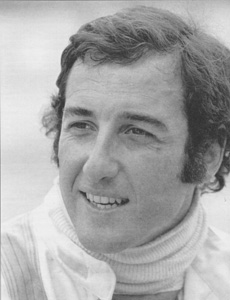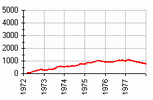Гонщики, P | |
Pace, Carlos Курсивом отмечены гонщики, |
| Карлуш ПасеPace, CarlosPace, Jose Carlos |
 (c) 'Who is Who' by Steve Small, 2000 Родился: 06.10.1944 Сан-Паулу Умер: 18.03.1977 Сан-Паулу Сезонов в Ф1: Лет в Ф1: 6 Гран При: Старты: 71* *не стартовал: 3 Победы: - подряд: Подиумы: - подряд: Поул-позиции: - подряд: Первый ряд: - подряд: 2 Быстрые круги: - подряд: 2 Лучший финиш: Лучший старт: 1 Дубли: Хет-трики: Лидирование старт/финиш: Большие шлемы: Круги: - лидирования: 50 Километры: - лидирования: |
Год | Команда | Шасси |
A long-time friend and rival of the Fittipaldi brothers - fellow Paulistas - Pace raced for most of the sixties in Brazil, beginning in karts where his opponents included Wilson Fittipaldi. Driving a variety of machines from Renault Gordinis to Formula Vee cars and a potent Alfa Romeo T33/2, Carlos took the Brazilian national championship three years in a row between 1967 and 1969.
Together with Wilson Fittipaldi, Carlos arrived in Europe in 1970 to contest a very competitive Formula 3 series with a Lotus 59 entered by Jim Russell. Despite his lack of knowledge of the British circuits, Pace was soon very much one of the front-runners and by the end of the year he had collected the Forward Trust championship. After spending his winter at home, where he endured a disappointing Torneio series, Carlos returned with a healthy dose of sponsorship which was eagerly accepted by Frank Williams, who provided a March for the Formula 2 season. Just as in F3 the previous year, Pace became one of the men to beat, and soon won a round at Imola, though the entry for this race wasn't one of the best.
Frank was keen to run Pace in his second F1 car in 1972, and the pair went 50/50 on a deal. While the unfortunate number one driver, Pescarolo, had a dreadful time, Carlos made good progress in the old March, taking valuable championship points in two of his first four races. Broadening his horizons, he briefly raced in Formula 2 with Pygmée, and then joined Ferrari's sports car team to take second place in the Österreichring 1000 Km, which brought an invitation from Gulf to race their Mirage at Watkins Glen, where he took third place. Late in the 1972 season, Pace dropped a bombshell on Williams by announcing his intention to join Surtees in 1973, and by the end-of-year Victory Race he was already installed in one of 'Big John's cars, taking second place in the TS9B. In 1973 he raced regularly for Surtees in Formula 1 and was a revelation. The highlights were his performances in Germany and Austria, but too many mechanical problems left him lowly placed in the final championship table. In tandem with F1, he drove for Ferrari in sports car events and, teamed with Merzario, took a string of placings, including second at Le Mans and the Nürburgring.
Despite the poor reliability of the Surtees, Carlos stayed with the team for 1974, but after a fourth place in his home GP, a succession of niggling problems blighted his prospects, and in mid-season he quit in frustration. It didn't take long for Bernie Ecclestone to bring him into the Brabham team alongside Carlos Reutemann and he soon proved to be every bit as competitive as his team-mate. A great drive in Austria was halted by a broken fuel line when victory seemed possible and he posted fastest race laps at Monza and Watkins Glen, where he served due notice of his intentions for the 1975 season. At Interlagos came the highlight of his career, his first Grand Prix win recorded in front of his ecstatic home fans, but luck rarely went his way throughout the year. His competitiveness was severely blunted in 1976 when Brabham ran Alfa Romeo engines, but he got stuck in and never gave up in his efforts to develop the car.
By the end of the year he was enthusiastic about his prospects for 1977. Second place in the Argentine Grand Prix vindicated his optimism, but prior to the start of the European season came the terrible news of his death in a light plane crash back in Brazil.
(c) 'Who is Who' by Steve Small, 2000
| © WildSoft, 1995-2020 |


